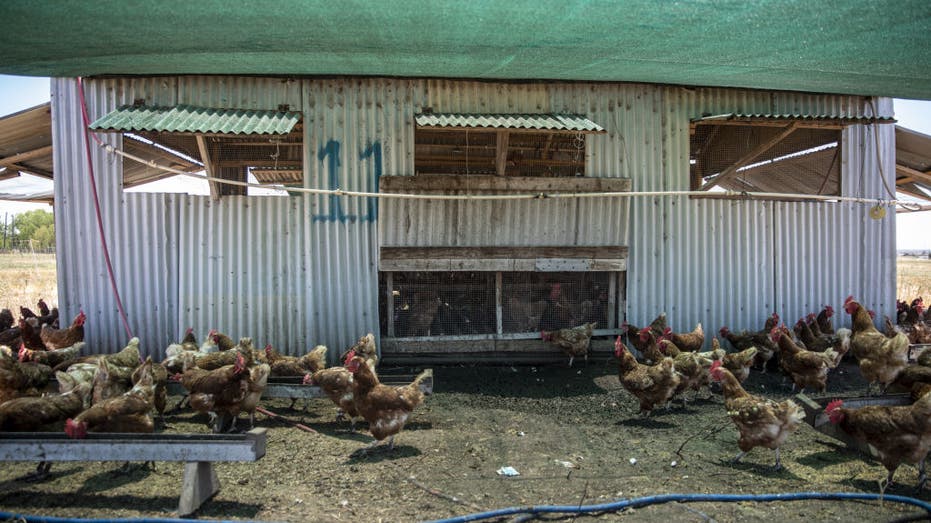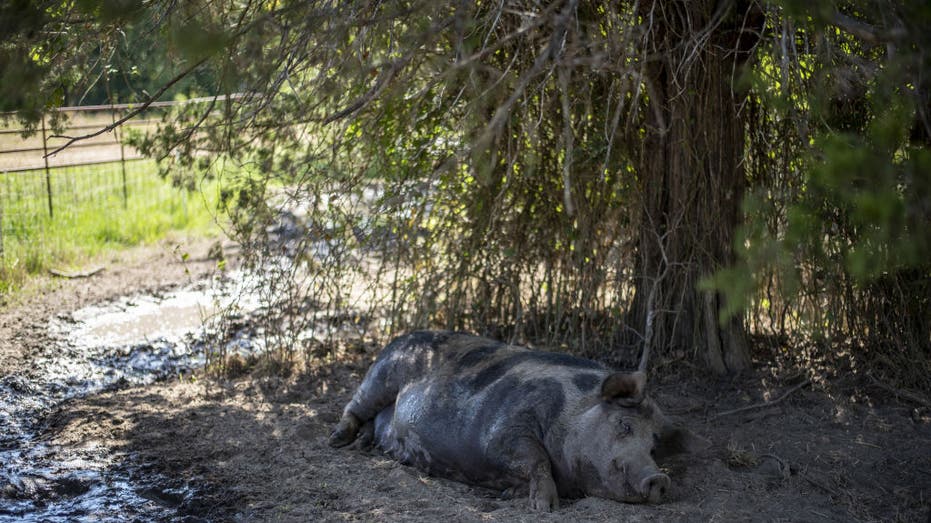Check out what’s clicking on FoxBusiness.com.
Scorching temperatures this past week have put swaths of the U.S., especially in the South and West, under excessive-heat warnings and advisories. The hot weather is hitting during an important period of the Midwest crop-growing season, analysts said, and just as some commodity prices ease amid concerns about global food supplies.
The heat is also exacerbating longer-running drought conditions in parts of Kansas, Oklahoma, Texas and other states, risking harm to livestock, parching pastures and leading ranchers to spend more on supplemental feed for cattle.

Cows take shelter under a water mist spray during a heatwave outside Elgin, Texas, US, on Wednesday, July 20, 2022. In Texas 100-degree Fahrenheit temperatures plus the soaring costs for feed, fertilizer, fuel and the lack of water and hay have made (Sergio Flores/Bloomberg via Getty Images / Getty Images)
In Iowa, which produces more corn than any other U.S. state, temperatures are forecast to hit 100 degrees in the western part of the state, according to the National Weather Service. Major livestock-producing states, including Texas and Oklahoma, are expected to see temperatures hit 104 degrees over the weekend. Some places in the region have had extremely hot and dry weather for prolonged periods.
Charlie Swanson, a third-generation cattle producer outside Roosevelt, Okla., said temperatures have climbed over 100 degrees every day since the start of the month, including a 114-degree day on Tuesday. Combined with scant rain, the heat is roasting his pastures, cutting into the grass and forage he raises to graze his cattle.
SELF-DRIVING TRACTORS ROLLING OUT IN CALIFORNIA COULD FUEL THE FUTURE OF FARMING
Recent high temperatures are particularly difficult for states experiencing drought conditions, such as Oklahoma. Ranchers in the region were already paying more for feed, fertilizer, fuel and other expenses, and are selling their calves into feedlots at a faster pace, according to Agriculture Department data. Mr. Swanson said his feed costs have climbed by roughly $100 a ton from a year ago, while fertilizer also has grown more expensive.
Mr. Swanson recently sold 80 of his cows to a beef packer in Texas because it was getting too expensive to keep feeding them, he said. During a drought, he said, ranchers often cull their less-productive cows that may cost more to feed.
“Everybody is cutting back on expenses if they can,” Mr. Swanson said.
The prices that ranchers receive for their cattle have climbed roughly 15% from a year ago, according to the USDA, but producers are still struggling to break even. Prices for hay, which is widely used to feed cattle, were 56% higher in April than in 2021, according to a June report from the Federal Reserve Bank of Kansas City. Cattle producers are estimated to have lost money the past two months, according to a cost-and-return analysis from Iowa State University.

Chickens under a shaded area of a farm during a heatwave outside, Elgin, Texas, US, on Wednesday, July 20, 2022. In Texas 100-degree Fahrenheit temperatures plus the soaring costs for feed, fertilizer, fuel and the lack of water and hay have made it (Sergio Flores/Bloomberg via Getty Images / Getty Images)
High temperatures also pose health risks for farm animals. Thousands of cattle in Kansas died in June as a result of excessive heat. In poultry, rolling blackouts and brownouts because of high temperatures in Southeastern states have been a concern for growers, who must constantly ventilate and cool their barns.
Panorama Organic Grass-Fed Meats, a division of poultry company Perdue Farms Inc., is trying to help ranchers move their cattle from drought-ridden states, said Kay Cornelius, Panorama’s general manager. For example, the company might connect a rancher in Bakersfield, Calif., who is struggling with dry weather with a producer in Nebraska looking to buy cattle. “We’re the matchmaker,” she said.
If the high heat persists in certain areas of the country and this year’s corn crop starts to take a hit, it could drive feed costs higher still for livestock producers, industry analysts say.
Eddie Sanders, a fourth-generation corn grower in Franklin, Tenn., said he expects to harvest only roughly one-third to one-half of his corn crop this year, because of the hot and dry weather. He said he is hoping to be able to salvage his soybean crop, but if the hot weather persists into August, that too might be at risk.
“We’re burned up here,” he said. “We’re at the mercy of a rain every 10 days.”
INFLATION TIMELINE: MAPPING THE BIDEN ADMIN’S RESPONSE TO RAPID PRICE GROWTH
Many Midwestern farms got a late start planting corn and other cropsbecause of a wet spring. In some areas, it is now too dry. Nearly 30% of U.S. corn production and 26% of soybean production are in areas experiencing drought, according to the U.S. Drought Monitor.
Corn is now pollinating in many parts of the grain belt, a time when the plants require the most water. Serious drought and heat stress during corn pollination can translate to yield losses of about 9% a day, said Dan Quinn, an agronomist at Purdue University and corn specialist who works with regional farmers.

A pig lays in the shade under a tree during a heatwave outside Paige, Texas, US, on Wednesday, July 20, 2022. In Texas 100-degree Fahrenheit temperatures plus the soaring costs for feed, fertilizer, fuel and the lack of water and hay have made it too (Sergio Flores/Bloomberg via Getty Images / Getty Images)
Some analysts and traders said crops remain in good shape. Big farm states including Illinois, Indiana and parts of Iowa have received rain recently, and the USDA’s crop report on July 18 showed steady corn conditions.
Corn futures prices at the Chicago Board of Trade have traded nearly 7% lower over the past week. Rainfall is in the forecast for parts of the Midwest next week, which should ease some crop concerns, analysts said.
Prices for agricultural commodities including corn and wheat have tumbled in recent weeks, following a monthslong surge touched off by Russia’s invasion of Ukraine in late February. Food and agriculture officials have warned that global grain supplies remain at risk, especially as poor weather casts uncertainty over important crop-growing regions.
CLICK HERE TO READ MORE FROM FOX BUSINESS
An abundant harvest would help ease concerns over global food supplies, but the U.S. is likely to face more yield-damaging heat this month, said Jon Davis, chief meteorologist at Everstream Analytics, a supply-chain risk-management company. Corn in the pollination stage begins to be stressed to the point of yield losses when temperatures exceed the mid-90s for several days with no relief during the night, he said.


